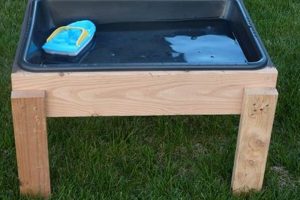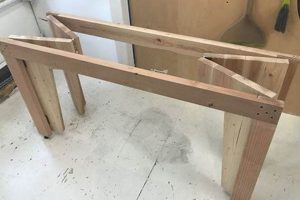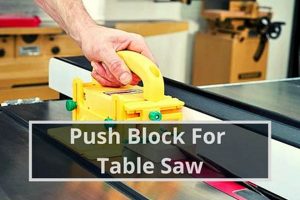A shop-constructed platform designed to accept a handheld rotary cutting tool transforms the portable device into a stationary tool. This modification offers enhanced control and precision when executing rip cuts, crosscuts, and other woodworking operations. For example, a common implementation involves securing a sidewinder-style cutter beneath a rigid surface, allowing the blade to protrude through a slot. The workpiece is then fed across the exposed blade.
Such a project provides cost savings compared to purchasing a dedicated stationary cutting machine. It also allows for customization to fit specific workspace constraints and project requirements. Historically, woodworkers have adapted portable tools to stationary applications to expand functionality without significant capital investment, fostering ingenuity and resourcefulness in the craft.
The following sections will detail critical aspects of construction, including material selection, safety considerations, and techniques for achieving accurate cuts. Detailed plans and instructions are readily available for various skill levels, enabling craftspeople to enhance their workshops with this versatile addition.
Important Considerations for Construction and Use
The following recommendations emphasize precision, safety, and optimal performance when building and operating the shop-fabricated workstation. Adherence to these guidelines will promote efficient workflow and reduce the risk of injury.
Tip 1: Material Selection is Critical: Utilize high-density materials such as plywood or MDF for the primary platform. These materials offer dimensional stability and resist warping, ensuring a flat and consistent work surface. Avoid using thin or flexible materials that may deflect during operation, compromising accuracy.
Tip 2: Prioritize Blade Alignment: Precise alignment between the blade and the fence is paramount for achieving accurate cuts. Use a precision square to verify the fence is perpendicular to the blade’s path. Misalignment results in angled cuts and potential binding, increasing the risk of kickback.
Tip 3: Implement Effective Dust Collection: Sawdust accumulation impairs visibility and presents a respiratory hazard. Integrate a dust collection port directly beneath the blade. Connecting this port to a shop vacuum or dust collection system significantly reduces airborne particulate matter.
Tip 4: Secure the Cutting Tool Properly: Ensure the rotary cutting tool is firmly attached to the platform. Use appropriate fasteners and mounting hardware to prevent movement or vibration during operation. Loose mounting compromises control and introduces safety risks.
Tip 5: Employ a Zero-Clearance Insert: A zero-clearance insert minimizes the gap around the blade, reducing tear-out and splintering. Create a custom insert from a matching material, precisely sized to the blade’s kerf. This improves cut quality, especially when working with delicate materials.
Tip 6: Incorporate Safety Features: Install a blade guard and anti-kickback pawls to mitigate potential hazards. These safety devices provide a physical barrier between the operator and the blade, reducing the risk of accidental contact and preventing workpiece kickback.
Tip 7: Regular Maintenance is Essential: Routinely inspect the platform, blade, and safety devices. Clean sawdust accumulation and lubricate moving parts as necessary. Dull blades should be sharpened or replaced promptly to maintain cutting efficiency and reduce strain on the motor.
Consistent application of these guidelines will improve the accuracy, safety, and longevity of the shop-built workstation, allowing for more efficient and precise woodworking operations.
By adhering to safety protocols and prioritizing accuracy in the build process, the resultant tool becomes a valuable asset in any workshop.
1. Accuracy
The utility of a shop-constructed cutting platform is directly proportional to the precision it affords. In woodworking, dimensional exactitude is paramount, influencing joint integrity, structural stability, and the aesthetic quality of finished pieces. Consequently, the inherent value of this project lies in its capacity to deliver repeatable, accurate cuts. Imprecise cuts can lead to misalignment, weakened joints, and ultimately, project failure. An example: If the rip fence is not perfectly parallel to the blade, each rip cut will deviate increasingly from the desired width, resulting in waste and rework. This precision is not merely desirable but fundamentally necessary.
The achievement of accuracy is contingent upon several factors inherent in the construction. Rigid platform construction minimizes vibration. Precise blade alignment, often verified with a digital angle finder, ensures square cuts. Furthermore, a well-calibrated fence system allows for consistent measurements and reliable repetition. This careful approach transforms a potentially imprecise handheld tool into a controlled, accurate cutting instrument. For example, a carefully crafted fence combined with featherboards allows for the safe and precise cutting of thin strips, an operation that would be difficult and potentially dangerous with the handheld device alone.
In summary, accuracy is not merely a desirable attribute but the foundational principle upon which the utility and value of the shop-constructed cutting platform rest. Challenges include the need for careful calibration and maintenance to retain precision over time. Addressing these challenges ensures the tool remains a valuable asset, enabling the creation of high-quality woodworking projects with confidence.
2. Stability
Stability is a foundational element in the design and functionality of any shop-constructed cutting platform. It directly influences the accuracy, safety, and overall usability of the tool. A lack of rigidity can compromise the precision of cuts, increase the risk of kickback, and reduce the lifespan of the structure.
- Platform Rigidity
The platform must resist deformation under load. Materials such as thick plywood or MDF, properly braced, are crucial. Flexing or vibration during operation introduces inaccuracies and potential hazards. For instance, a wobbly table will make it impossible to achieve consistent rip cuts, rendering the entire project flawed.
- Base Support
The base provides the primary support for the platform and must be equally stable. A robust frame constructed from solid wood or metal is essential. Leveling feet can compensate for uneven floors, preventing rocking or tilting. An unstable base can cause the platform to shift during cutting, leading to inaccurate results and increased risk.
- Motor Mounting Security
The handheld rotary cutting tool must be securely mounted to the underside of the platform. Proper mounting hardware and a solid mounting plate are necessary to prevent movement or vibration. A loose or improperly mounted tool introduces instability, jeopardizing accuracy and potentially damaging the tool or the platform.
- Workpiece Support
Adequate support for the workpiece is critical to maintaining stability throughout the cutting process. Outfeed supports, extension wings, or roller stands can prevent sagging or tipping, especially when working with large or heavy materials. Lack of support can cause the workpiece to bind or shift, leading to inaccurate cuts and potential kickback.
The integration of these stability elements is paramount in ensuring the safe and accurate operation of the shop-constructed cutting tool. By prioritizing rigidity and support throughout the design and construction process, the user can create a reliable and versatile tool for a variety of woodworking applications. Ignoring these aspects compromises the functionality and safety, rendering the entire endeavor less effective.
3. Safety Features
The incorporation of safety features into a shop-constructed cutting platform is not merely a precautionary measure but an essential design parameter. The handheld rotary cutting tool, when inverted and integrated into a table configuration, presents unique hazards that demand specific safeguards. The absence of adequate safety provisions can result in severe injury, underscoring the critical importance of these features.
Consider, for instance, the risk of kickback. Kickback occurs when the blade binds within the material, causing the workpiece to be violently ejected back toward the operator. Anti-kickback pawls, one-way toothed devices, prevent this by gripping the workpiece and stopping its rearward movement. Similarly, blade guards offer a physical barrier against accidental contact with the rotating blade, reducing the likelihood of lacerations. Splitters, positioned behind the blade, maintain an open kerf, preventing the material from pinching the blade and initiating kickback. A simple push stick, used to guide the workpiece, keeps hands safely away from the cutting edge. Each feature addresses a specific risk associated with the modified tool.
The integration of safety features into a cutting platform transforms a potentially dangerous tool into a manageable and relatively safe workstation. While these features do not eliminate all risk, they significantly mitigate the potential for injury. Disregarding these elements introduces unacceptable hazards and undermines the intended utility of the shop-constructed cutting apparatus. The selection, installation, and proper maintenance of these safeguards are therefore non-negotiable aspects of its design and operation.
4. Dust Collection
The integration of effective dust collection mechanisms is paramount for the safe and efficient operation of a shop-constructed cutting platform. Sawdust generated during cutting processes poses significant health risks and hinders visibility, thereby compromising accuracy and overall working conditions. A well-designed dust collection system mitigates these concerns.
- Health and Safety Implications
Exposure to fine wood dust is a recognized respiratory irritant and potential carcinogen. Prolonged inhalation can lead to various respiratory ailments and increased risk of certain cancers. Implementing adequate dust collection minimizes airborne particulate matter, safeguarding the operator’s health. Neglecting this aspect constitutes a severe safety oversight.
- Visibility and Precision
Accumulated sawdust obscures the cut line, making precise alignment and accurate cutting difficult. Reduced visibility increases the likelihood of errors and potential accidents. A dust collection system removes sawdust as it is generated, ensuring a clear view of the cutting path and facilitating precise execution.
- Component Integration
Effective dust collection typically involves a combination of strategically positioned dust ports, a shroud or enclosure around the blade, and a powerful vacuum or dust collector. The dust port should be located as close as possible to the blade to capture the majority of the generated dust. A sealed enclosure further prevents dust from escaping into the surrounding environment. The vacuum or dust collector provides the necessary suction to remove the dust from the collection point.
- System Design Considerations
The design of a dust collection system must consider factors such as airflow, hose diameter, and filtration efficiency. Adequate airflow is essential for effectively capturing and removing dust. Insufficient airflow renders the system ineffective. The hose diameter must be appropriately sized to maintain sufficient suction. High-efficiency filters prevent fine dust particles from being exhausted back into the workshop.
The implementation of a comprehensive dust collection system is an indispensable aspect of a shop-constructed cutting platform. It not only protects the operator’s health and safety but also enhances precision, improves visibility, and contributes to a cleaner and more efficient working environment. Prioritizing dust collection is not merely a best practice; it is a fundamental requirement for responsible woodworking.
5. Blade Alignment
Precise blade alignment constitutes a cornerstone of functionality and safety within a shop-constructed cutting platform. The relative position of the blade to the fence, miter slot, and table surface dictates the accuracy of cuts, the potential for workpiece binding, and the overall operational safety of the apparatus. Misalignment introduces a cascade of detrimental effects, impacting both the quality of finished products and the well-being of the operator. For instance, if the blade is not perfectly parallel to the miter slot, mitered cuts will inevitably deviate from the intended angle, leading to poorly fitting joints and compromised structural integrity. Conversely, a blade angled relative to the fence can cause the workpiece to bind during rip cuts, increasing the risk of kickback and potential injury.
The achievement of proper alignment necessitates meticulous setup and calibration. This process involves the use of precision measuring tools, such as squares and dial indicators, to ensure the blade is perpendicular to the table surface and parallel to both the fence and miter slot. Adjustments may be required at the point where the handheld rotary cutting tool is mounted to the underside of the platform. For example, shimming the mounting plate can correct minor angular deviations. The repetitive nature of woodworking tasks amplifies the importance of consistent blade alignment. Once established, the alignment should be periodically checked and adjusted as needed to maintain accuracy over time. Real-world examples abound: cabinetry relies heavily on precisely square cuts, which are impossible without proper blade alignment, as is accurate joinery of any kind.
In summation, blade alignment is not a peripheral concern but a fundamental prerequisite for a functional and safe shop-constructed cutting platform. Neglecting this aspect renders the tool inaccurate, unreliable, and potentially dangerous. Regular inspection and adjustment are essential to upholding the integrity of cuts and minimizing the risk of operational hazards. The direct correlation between blade alignment and the quality and safety of work performed underscores its significance within the context of this type of tool construction and use.
6. Material Selection
Material selection exerts a profound influence on the performance, safety, and longevity of a shop-constructed cutting platform. The chosen materials directly impact structural integrity, resistance to vibration, and the ability to maintain precise blade alignment. The selection process therefore warrants careful consideration, balancing cost-effectiveness with performance requirements.
- Platform Surface Material
The material used for the primary work surface dictates its flatness, dimensional stability, and resistance to wear. High-density materials, such as MDF (Medium-Density Fiberboard) or Baltic birch plywood, are preferred due to their uniform density and resistance to warping. Lower-grade plywood or particleboard may exhibit inconsistencies and are more susceptible to deformation under load. For example, a surface made of thin, low-grade plywood will flex during operation, compromising the accuracy of cuts.
- Frame and Support Structure Materials
The frame and support structure provide the necessary rigidity to the platform. Solid wood, steel, or a combination of both are commonly employed. Softwoods, such as pine, may be adequate for smaller platforms but lack the stiffness required for larger, heavy-duty constructions. Steel offers superior strength and dimensional stability but requires welding or bolted connections. Hybrid designs, utilizing a steel frame with wooden bracing, can offer a balance of strength and ease of construction. A weak or unstable frame transmits vibrations to the work surface, hindering precision.
- Fastening Hardware Materials
The type and quality of fasteners significantly influence the strength and durability of the assembled platform. Screws, bolts, and adhesives must be selected based on the materials being joined and the anticipated loads. Using undersized or low-quality fasteners can lead to joint failure and structural instability. For example, using drywall screws in place of wood screws can cause the screws to shear under stress, compromising the integrity of the frame.
- Mounting Plate Material
The mounting plate, which secures the handheld rotary cutting tool to the underside of the platform, must be rigid and resistant to deformation. Steel or aluminum are commonly used for this component. A flexible or poorly secured mounting plate allows the tool to vibrate, leading to inaccurate cuts and potential damage to the tool or platform. Furthermore, the selected material must be compatible with the cutting tool’s mounting hardware to ensure a secure and vibration-free connection.
The collective impact of these material choices shapes the overall performance of the shop-constructed cutting platform. Prioritizing high-quality, dimensionally stable materials, coupled with appropriate fastening techniques, is essential for creating a durable, accurate, and safe tool. Conversely, compromising on material quality can result in a platform that is prone to vibration, misalignment, and premature failure.
7. Versatility
The adaptability of a shop-constructed rotary cutting platform significantly enhances its value within a woodworking environment. The ability to perform a range of cutting operations, accommodate various material thicknesses, and integrate with auxiliary tools elevates its utility beyond a simple stationary cutter. Versatility stems from design choices that allow for adjustments, attachments, and modifications, expanding the tool’s capabilities. The absence of versatility limits the tool’s application, potentially requiring additional specialized equipment to complete diverse woodworking projects. For example, a platform designed solely for ripping lumber lacks the capacity for crosscutting or mitered cuts, necessitating the use of a separate miter saw or other cutting method.
Specific design elements contribute directly to increased adaptability. An adjustable fence system allows for the precise setting of rip cuts and the creation of angled cuts. The integration of a miter slot facilitates the use of miter gauges and sleds for accurate crosscutting and angled cuts. An adjustable blade height mechanism enables the cutting of materials of varying thicknesses. The ability to add extension wings or outfeed supports accommodates larger workpieces. Examples include the creation of custom moldings, the construction of picture frames, and the fabrication of complex joinery, all of which require a versatile cutting tool capable of adapting to different tasks and materials.
In summary, versatility is a critical attribute of a shop-constructed rotary cutting platform, expanding its functionality and enabling a wider range of woodworking tasks. Strategic design considerations, such as adjustable fences, miter slots, and blade height mechanisms, contribute directly to enhanced adaptability. The limitations of a non-versatile design necessitate the use of additional tools and specialized equipment, reducing efficiency and increasing overall project costs. Therefore, incorporating versatility into the design process significantly elevates the tool’s overall value and practicality.
Frequently Asked Questions
This section addresses common inquiries and concerns regarding the design, construction, and safe operation of cutting platforms built for rotary cutting tools. The information presented is intended to provide clarity and promote informed decision-making.
Question 1: Is constructing a cutting platform a viable alternative to purchasing a commercially manufactured cutting machine?
The viability of a shop-constructed cutting platform depends on individual needs and circumstances. Commercially manufactured machines offer features such as integrated dust collection, precision fences, and safety mechanisms that may not be easily replicated in a home-built version. However, a shop-built platform can offer cost savings, customization options, and the satisfaction of creating a functional tool. Careful consideration of required features, skill level, and budget is essential.
Question 2: What are the primary safety considerations when using a shop-constructed cutting platform?
The primary safety considerations include blade guards, anti-kickback pawls, push sticks, and adequate dust collection. The operator must also wear appropriate personal protective equipment, such as eye protection and a dust mask. Understanding the principles of safe operation and adhering to all safety guidelines is crucial to prevent accidents.
Question 3: What types of rotary cutting tools are suitable for use with a shop-constructed cutting platform?
Most handheld rotary cutting tools can be adapted for use with a cutting platform. However, the size and power of the tool should be considered. Smaller, lightweight tools are generally easier to mount and control. Larger, more powerful tools may require a more robust platform to ensure stability and prevent vibration. Sidewinder style tools are often easier to mount due to their flat sides.
Question 4: What materials are best suited for constructing a cutting platform?
High-density materials, such as MDF or Baltic birch plywood, are generally preferred for the platform surface due to their dimensional stability and resistance to warping. The frame and support structure should be constructed from solid wood or steel to provide adequate strength and rigidity. Fasteners should be selected based on the materials being joined and the anticipated loads.
Question 5: How can accurate blade alignment be achieved and maintained on a shop-constructed cutting platform?
Accurate blade alignment requires meticulous setup and calibration. A precision square and dial indicator are essential tools for verifying the blade’s perpendicularity to the table surface and parallelism to the fence. Adjustments can be made by shimming the mounting plate or adjusting the fence position. Regular checks and adjustments are necessary to maintain accuracy over time.
Question 6: How can dust collection be effectively implemented on a shop-constructed cutting platform?
Effective dust collection typically involves a combination of strategically positioned dust ports, a shroud or enclosure around the blade, and a powerful vacuum or dust collector. The dust port should be located as close as possible to the blade to capture the majority of the generated dust. A sealed enclosure further prevents dust from escaping into the surrounding environment. Adequate airflow and filtration are essential for optimal performance.
The construction of a shop-built cutting platform requires careful planning, attention to detail, and a commitment to safety. When properly designed and constructed, it can provide a valuable and versatile tool for woodworking applications.
The following section will cover advanced techniques and modifications for enhancing the capabilities of a shop-constructed cutting platform.
DIY Circular Saw Table
This exploration of the shop-fabricated rotary cutting platform has emphasized core principles: safety, accuracy, stability, dust management, material selection, and versatility. These elements, when meticulously addressed, converge to form a functional alternative to commercially produced machines. The successful implementation of such a project hinges upon a thorough understanding of these intertwined factors. The careful balancing of budgetary constraints with performance requirements remains paramount.
Woodworkers and craftspeople are encouraged to approach the creation of a diy circular saw table with diligence, prioritizing safety protocols and striving for dimensional precision. Continuous evaluation and refinement of the design will yield a valuable addition to any workshop. The lasting value of this endeavor lies not only in the cost savings realized but also in the acquired knowledge and enhanced craftsmanship skills fostered during its construction.







